🐶 Tibetan Terrier Hypoallergenic GuideCharacter, Grooming & Suitability 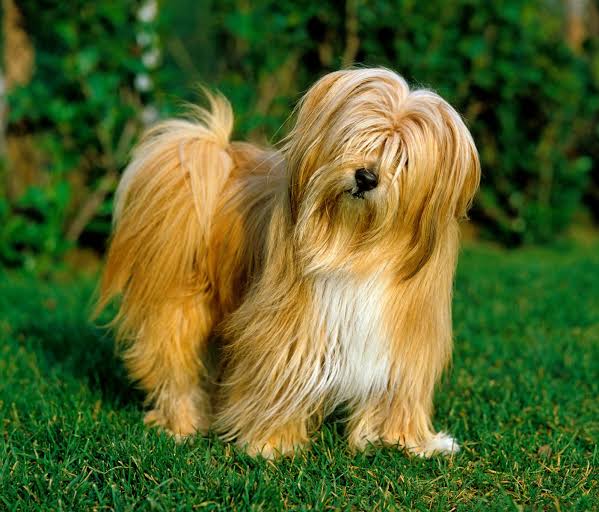
Tibetan Terrier with beautiful flowing coat
🟠 Hypoallergenic Level: MODERATELY HYPOALLERGENIC
🏷️ Key CharacteristicsBreed Overview
Size: Medium
Height: 14-17 inches (35-43 cm)
Weight: 18-30 lbs (8-14 kg)
Lifespan: 12-15 years
Colors: White, gold, cream, grey, black, tricolor, brindle
Activity Level: Medium to High
Grooming Needs: High - requires regular maintenance
Hypoallergenic: Yes (Moderately)
Low-shedding double coat
Care Difficulty: Moderate - needs commitment
🌟 Hypoallergenic Status ExplainedThe Tibetan Terrier is classified as moderately hypoallergenic because while they have a non-shedding double coat that traps dander, they still produce allergens through saliva and skin. Regular grooming significantly reduces allergen levels, making them suitable for many allergy sufferers, though individual reactions may vary. They are not completely hypoallergenic but are among the better choices for people with mild to moderate dog allergies. 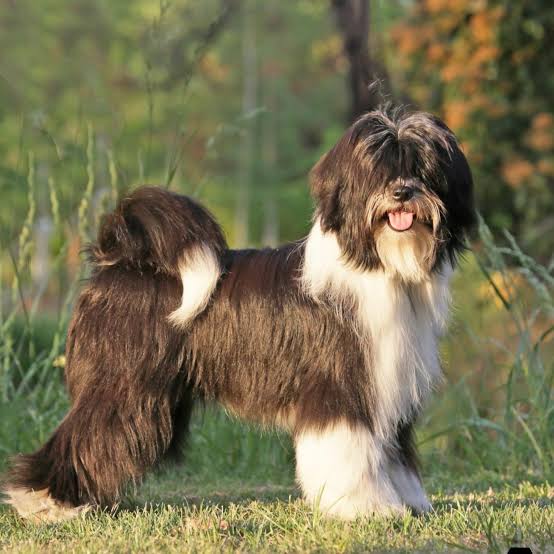
Black and white Tibetan Terrier showcasing breed standard
🏛️ Origin & HistoryThe Tibetan Terrier is one of the most ancient dog breeds, with a history spanning over 2,000 years in the remote Himalayan mountains of Tibet. Despite their name, they are not true terriers but were given this designation by European travelers who noticed their size was similar to terrier breeds. In their homeland, they were known as "Tsang Apso" or the "shaggy dog from the Tsang province." 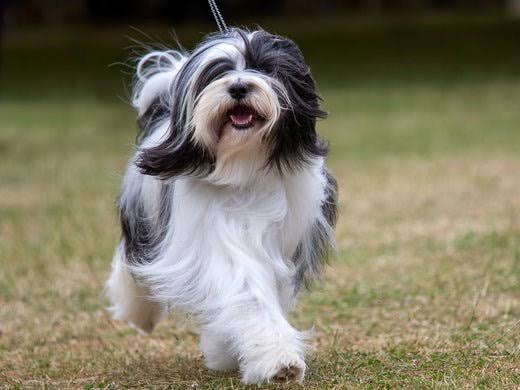
Energetic Tibetan Terrier in motion
These dogs were bred and raised exclusively by Tibetan monks and nomadic tribes in the monasteries and villages of the Lost Valley. They were considered sacred animals, believed to bring good luck to their owners, and were never sold but only given as gifts or tokens of gratitude. The breed served multiple purposes: they were watchdogs, companions, herders of livestock, and even retrieved items that fell down the mountainous terrain. Their unique foot structure, with large, flat, round feet, allowed them to navigate the treacherous mountain paths like natural snowshoes. The breed remained isolated in Tibet until the early 20th century when Dr. Agnes Greig, a British physician, received a Tibetan Terrier as a gift of gratitude from a grateful patient in the 1920s. She was so impressed with the breed that she established a breeding program and brought them to the Western world. The Tibetan Terrier was officially recognized by The Kennel Club in the UK in 1937 and by the American Kennel Club in 1973, where they became increasingly popular as both companion animals and show dogs. 💕 Character & Temperament
Adorable Tibetan Terrier puppy at mealtime
Tibetan Terriers possess a charming and complex personality that reflects their heritage as monastery companions and working dogs. They are highly intelligent, sensitive, and deeply devoted to their families, forming exceptionally strong bonds with their owners. Unlike many breeds, they are not typically one-person dogs but rather distribute their affection among all family members, making them excellent family companions. These dogs exhibit a gentle yet playful nature with a touch of mischievousness that keeps their families entertained. They have retained their watchdog instincts from their monastery days and will alert their owners to anything unusual, though they are not excessive barkers. Tibetan Terriers can be somewhat reserved with strangers initially, taking time to warm up to new people, which is a characteristic inherited from their protective heritage. However, once they accept someone, their friendliness knows no bounds. 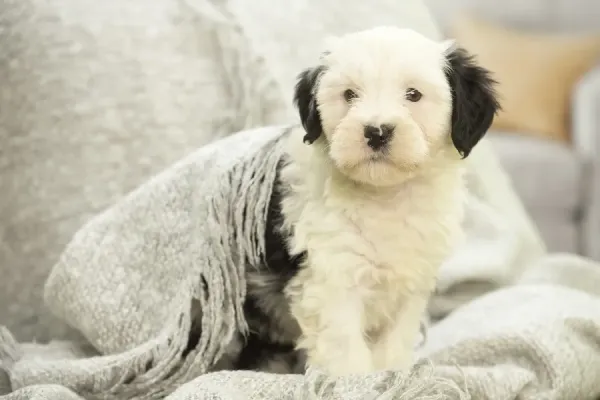
Peaceful Tibetan Terrier puppy resting indoors
One of the breed's most endearing qualities is their remarkable sensitivity to human emotions. Tibetan Terriers seem to have an intuitive understanding of their owner's moods and will often adjust their behavior accordingly, offering comfort when needed or playful distraction when appropriate. They thrive on human companionship and do not do well when left alone for extended periods, potentially developing separation anxiety. Their intelligence makes them quick learners, but they also have an independent streak that requires patient, positive reinforcement training. They respond poorly to harsh corrections and much better to gentle guidance and praise. 👀 Physical Appearance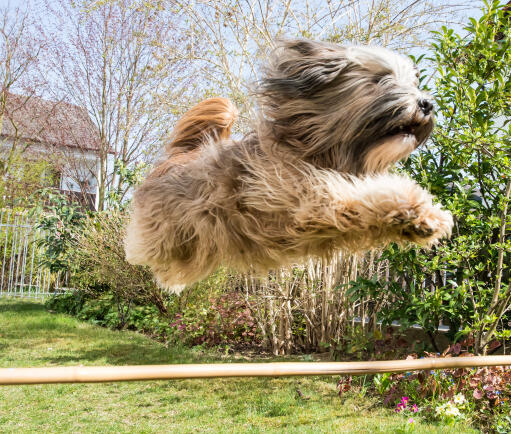
Athletic Tibetan Terrier demonstrating impressive agility
The Tibetan Terrier is a strikingly beautiful, medium-sized dog with a distinctive shaggy appearance that immediately catches the eye. Their most notable feature is their profuse double coat, consisting of a fine, woolly undercoat and a long, straight or slightly wavy outer coat that falls naturally to either side of the body. The coat is luxurious and flowing, covering their entire body including their face, creating the characteristic "beard" and "fall" over the eyes that gives them an endearing, almost mystical appearance. Built for functionality in harsh mountain terrain, Tibetan Terriers have a compact, square, and sturdy body structure. Their most unique physical characteristic is their large, flat, round feet, often described as "snowshoe feet," which provided traction on mountain trails and snow. They have a moderately long, well-feathered tail that curves over their back. Their head is proportional to their body, with a moderate stop and a black nose. Perhaps most captivating are their large, dark, expressive eyes that seem to look directly into your soul, though they are often partially hidden behind their characteristic hair fall. The breed comes in a wide variety of colors and combinations, including white, gold, cream, grey, smoke, black, parti-color, and tricolor. No color is considered more correct than another, and this variety adds to the breed's appeal. The coat texture is neither silky nor woolly but somewhere in between, designed to protect them from extreme weather conditions. Despite their profuse coat, the dog underneath is athletic and well-proportioned, capable of the agility and endurance their mountain heritage required. 🔍 Discover Your Ideal Hypoallergenic MatchWondering if a Tibetan Terrier is the right hypoallergenic breed for your home? Our specialized breed selector tool evaluates your lifestyle, allergy sensitivity, and living conditions to recommend the perfect canine companion. Find your perfect hypoallergenic companion in just 2 minutes! 🏃 Activity Needs
Tibetan Terrier enjoying autumn scenery
Tibetan Terriers have moderate to high energy levels and require regular daily exercise to maintain their physical health and mental well-being. As descendants of working mountain dogs, they possess impressive stamina and agility despite their moderate size. A minimum of 45-60 minutes of daily exercise is recommended, which can be divided into multiple walks and play sessions throughout the day. These dogs excel at various activities beyond simple walks. They particularly enjoy hiking, agility training, and interactive games that challenge both their body and mind. Their mountain heritage means they are naturally suited for terrain that might challenge other breeds, and they absolutely love outdoor adventures in varied landscapes. However, they are adaptable enough to get sufficient exercise in urban environments through longer walks, trips to dog parks, and indoor play sessions during inclement weather. Mental stimulation is equally important as physical exercise for this intelligent breed. Puzzle toys, training sessions, hide-and-seek games, and learning new tricks help keep their clever minds engaged. Without adequate mental and physical activity, Tibetan Terriers may develop behavioral issues such as excessive barking, destructive chewing, or digging. They also enjoy canine sports like rally, obedience, and even therapy dog work, where their gentle nature and intuitive understanding of human emotions make them naturals. ✂️ Grooming Care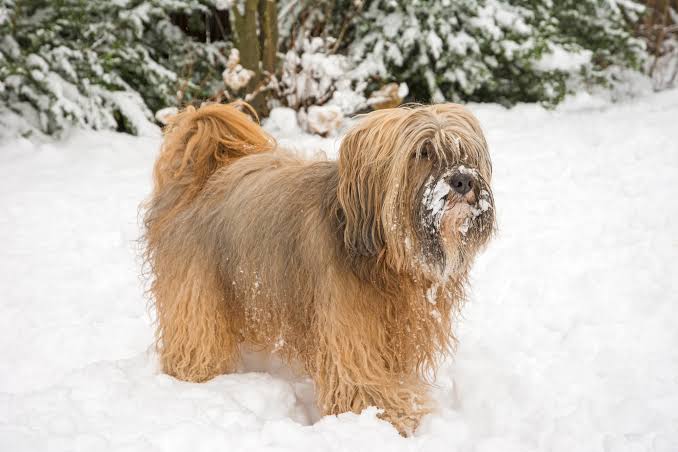
Tibetan Terrier's double coat in snowy conditions
The Tibetan Terrier's magnificent double coat requires significant grooming commitment, which is essential not only for appearance but also for maintaining their moderately hypoallergenic status. Their coat does not shed in the traditional sense; instead, loose hair becomes trapped in the coat and must be brushed out regularly. This characteristic is what makes them more suitable for allergy sufferers, but it also means that neglected coats will quickly develop painful mats and tangles. Daily brushing is highly recommended, with a minimum of thorough brushing 3-4 times per week. The process requires proper tools including a pin brush, a slicker brush, and a metal comb for working through the layers of the coat. The grooming session should be systematic, working through the coat in sections from the skin outward to prevent matting. Pay special attention to areas prone to tangling such as behind the ears, under the legs, and around the collar area. Many owners find that establishing a grooming routine from puppyhood makes the process easier and more enjoyable for both dog and owner. 
Beautifully groomed Tibetan Terrier
Bathing should be done every 4-6 weeks or as needed, using a high-quality dog shampoo followed by conditioner to keep the coat manageable. The coat must be completely brushed out before bathing, as water will set any existing tangles into impossible mats. After bathing, the coat needs thorough drying and brushing to prevent matting. Many owners choose to take their Tibetan Terriers to professional groomers every 6-8 weeks for a thorough grooming session, though some opt for a shorter "puppy cut" to reduce maintenance. Additional grooming needs include regular nail trimming every 3-4 weeks, checking and cleaning ears weekly to prevent infections, and dental care including regular tooth brushing. The hair between the foot pads should be trimmed regularly to prevent matting and improve traction. The hair over the eyes can be either trimmed for visibility or tied up in a topknot. For allergy sufferers, regular grooming is particularly important as it removes trapped dander and reduces allergen buildup in the coat. 🍽️ Nutrition Needs
Active Tibetan Terrier enjoying playtime
Proper nutrition is essential for maintaining the Tibetan Terrier's health, energy levels, and magnificent coat. Adult Tibetan Terriers typically require 1 to 1.5 cups of high-quality dry dog food per day, divided into two meals. However, the exact amount varies based on the dog's age, size, activity level, metabolism, and overall health. Active dogs or those with higher energy expenditure may require more food, while less active or senior dogs may need less to prevent obesity. Choose a premium dog food formulated for medium-sized breeds with high-quality protein as the first ingredient. The diet should contain appropriate levels of protein (22-26% for adults), healthy fats including omega-3 and omega-6 fatty acids for coat health, complex carbohydrates for sustained energy, and essential vitamins and minerals. Many Tibetan Terrier owners find that foods rich in omega fatty acids particularly benefit the breed's coat condition and help reduce skin issues that might trigger allergies in sensitive individuals. Tibetan Terriers can be prone to food sensitivities and allergies, so monitor your dog's response to their diet carefully. Signs of food issues include skin irritation, excessive scratching, ear infections, or digestive problems. Some Tibetan Terriers do well on grain-free formulas, while others thrive on traditional recipes. Avoid overfeeding and monitor body condition regularly, as obesity can lead to joint problems and other health issues. Fresh, clean water should always be available. Treats should constitute no more than 10% of daily caloric intake and can be useful for training, but choose healthy options and account for them in the daily food allowance. Puppies have different nutritional needs and should be fed puppy-specific formulas three to four times daily until six months of age, then transition to twice-daily feeding. Senior dogs (typically 7+ years) may benefit from senior formulas with adjusted protein and calorie levels. Always consult with your veterinarian to determine the best diet for your individual Tibetan Terrier's specific needs and health conditions. 👨👩👧👦 Suitable ForFamilies with ChildrenTibetan Terriers can be excellent family dogs and generally do very well with children, especially when raised with them from puppyhood. They are patient, gentle, and playful, making them wonderful companions for kids who understand how to interact respectfully with dogs. Their sturdy build means they can handle the active play that comes with family life, yet they are not so large as to accidentally knock over smaller children. However, as with all breeds, supervision is important during interactions between dogs and young children. The breed's sensitive nature means they respond well to children who are taught to be gentle and respectful. They do not tolerate rough handling, pulling of their coat, or overly aggressive play. Teaching children proper dog etiquette is essential – no pulling ears or tail, respecting the dog's space when eating or sleeping, and understanding the dog's body language. Tibetan Terriers will often seek out children for companionship and playtime, forming strong bonds with younger family members. Their protective instincts also mean they often naturally watch over children in the household. Apartment LivingDespite their mountain heritage, Tibetan Terriers adapt remarkably well to apartment living, making them suitable for urban environments. Their moderate size is ideal for smaller living spaces, and they can be quite calm indoors when their exercise needs are met. They are not typically excessive barkers, though they will alert to unusual sounds or visitors, which actually makes them good watchdogs without being a nuisance to neighbors. The key to successful apartment living with a Tibetan Terrier is commitment to daily exercise and mental stimulation. They need regular walks, trips to dog parks, and interactive play sessions to burn off energy. Without adequate activity, they may become restless or develop behavioral issues. Access to outdoor spaces for bathroom breaks is important, and establishing a consistent routine helps them adjust to apartment life. Their non-shedding coat is also an advantage in smaller living spaces, as it doesn't leave fur all over furniture and floors, though regular grooming outside the apartment is advisable. Owner Experience LevelTibetan Terriers are best suited for owners with some dog experience, though motivated first-time owners willing to invest time in learning can certainly succeed with this breed. They are not recommended as a first dog for someone unwilling to commit to extensive grooming and training. Their intelligence and independent nature require patient, consistent training with positive reinforcement methods. They are sensitive dogs who do not respond well to harsh corrections or inconsistent rules. The grooming requirement alone makes this a breed that demands dedication and commitment. Prospective owners must honestly assess whether they have the time and willingness to brush their dog several times weekly and maintain regular grooming appointments. Additionally, their need for companionship means they are not suitable for people who work long hours without the ability to come home during the day or provide dog daycare. They thrive with owners who can include them in daily activities and provide the social interaction they crave. First-time owners who are prepared for these commitments and willing to learn proper training and grooming techniques can develop wonderful relationships with Tibetan Terriers, but those seeking a low-maintenance breed should look elsewhere. ⚖️ Pros & Cons✅ Advantages
❌ Challenges
❓ Frequently Asked QuestionsAre Tibetan Terriers truly hypoallergenic?Tibetan Terriers are moderately hypoallergenic, not completely hypoallergenic. They have a non-shedding double coat that traps loose hair and dander rather than releasing it into the environment, which significantly reduces allergen exposure compared to heavy-shedding breeds. However, they still produce allergens through their saliva, skin, and urine. Many people with mild to moderate dog allergies can live comfortably with Tibetan Terriers, especially with regular grooming and home cleaning routines. It's recommended that allergy sufferers spend time with the breed before committing to ensure compatibility. How much grooming does a Tibetan Terrier really need?Grooming is a significant time commitment with Tibetan Terriers. They require brushing 3-4 times per week minimum, with daily brushing being ideal to prevent mats and tangles. Professional grooming every 6-8 weeks is recommended, or owners can learn to groom at home. Each brushing session can take 30-60 minutes depending on coat condition and length. Bathing is needed monthly, along with regular nail trims, ear cleaning, and dental care. Many owners choose a shorter "puppy cut" to reduce maintenance, though this still requires professional grooming every 6-8 weeks and regular brushing at home. Do Tibetan Terriers bark a lot?Tibetan Terriers are moderate barkers who typically bark with purpose rather than excessively. They retain their watchdog instincts and will alert to unusual sounds, visitors, or activity, making them excellent alarm dogs. However, with proper training and socialization, they can learn appropriate barking behavior. They are not known for constant nuisance barking like some small breeds. Their tendency to bark can be managed through training, adequate exercise, and mental stimulation. A bored or under-exercised Tibetan Terrier may bark more than one whose needs are met. Can Tibetan Terriers be left alone during the workday?Tibetan Terriers do not tolerate long periods of isolation well and are prone to separation anxiety. They were bred as companion dogs and thrive on human interaction. Leaving them alone for a full 8-10 hour workday regularly is not recommended and can lead to destructive behavior, excessive barking, or depression. If you work full-time, consider options like dog daycare, a dog walker for midday visits, or bringing your dog to work if possible. They do much better with someone home during the day or with arrangements that break up alone time into shorter periods. Are Tibetan Terriers good with other pets?Yes, Tibetan Terriers generally get along well with other pets, especially when properly socialized from a young age. They typically coexist peacefully with other dogs and can even live harmoniously with cats and other household pets. Their gentle nature and lack of strong prey drive make them good companions for multi-pet households. However, as with any breed, proper introductions and supervision during initial meetings are important. They may be reserved initially with new animals but usually warm up quickly. Their social nature often means they appreciate having another dog companion in the home. What health issues are common in Tibetan Terriers?Tibetan Terriers are generally healthy with good genetic diversity, but they can be prone to certain conditions. Progressive Retinal Atrophy (PRA) is a concern, though responsible breeders test for this. Hip dysplasia, patellar luxation, and certain eye conditions can occur. They may also experience thyroid issues and neurological conditions like cerebellar abiotrophy. Dental problems are common due to their small mouth size. Reputable breeders conduct health screenings and genetic testing. Regular veterinary check-ups, maintaining healthy weight, proper exercise, and good dental care help prevent or manage many health issues. Their average lifespan of 12-15 years is excellent for a medium-sized breed. Why are they called terriers when they're not actually terriers?The name "Tibetan Terrier" is actually a misnomer given by European travelers who first encountered the breed outside Tibet. They noticed the dogs were similar in size to European terrier breeds and thus called them "terriers," but they are not true terriers and don't have typical terrier temperament or purpose. In Tibet, they were never called terriers but were known as "Tsang Apso" or "Dokhi Apso." True terriers were bred for hunting and going to ground after prey, while Tibetan Terriers were bred as companions, watchdogs, and herding dogs in Himalayan monasteries. They are more closely related to other Tibetan breeds and ancient Asian dogs than to any terrier group. What is the best way to train a Tibetan Terrier?Tibetan Terriers respond best to positive reinforcement training methods using rewards, praise, and patience. They are intelligent but can be independent and stubborn, so consistency is key. Harsh corrections or punishment will damage trust and make training much harder. Keep training sessions short (10-15 minutes), fun, and varied to hold their attention. Early socialization is crucial – expose puppies to various people, places, sounds, and experiences. They excel in activities that engage their minds like agility, tricks, and puzzle-solving. Building a strong bond and mutual respect makes training far more effective than trying to dominate this sensitive breed. The Tibetan Terrier is a remarkable breed that offers loyal companionship, moderate hypoallergenic qualities, and a unique blend of ancient heritage with adaptable modern temperament. While they require significant grooming commitment and dedicated training, their loving nature and striking beauty make them wonderful companions for the right families. | |
|
| |
| Переглядів: 99 | | |
| Total comments: 0 | |
